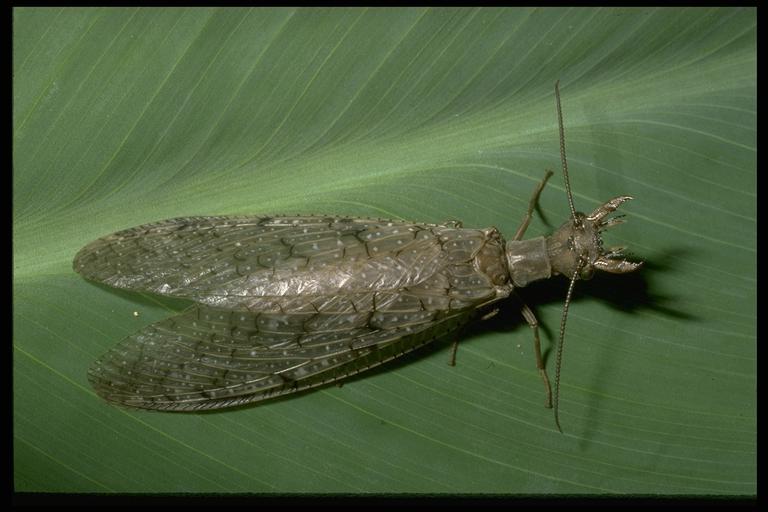
A hellgrammite, Corydalus sp. (Neuroptera: Corydalidae). Photo by Drees.
Common Name: Dobsonfly
Scientific Name: Corydalus sp.
Order: Neuroptera
Description: Dobsonflies are large (can be over 2 inches long), and have long antennae. Their large, many veined forewings are often mottled. When at rest, wings are held flat over the back and extend beyond the abdomen. Males have long, extended curved mandibles which are used to grasp the female during mating. Aquatic immature stages, called hellgrammites are elongate, dull colored larvae with gill filaments and feathery gill clusters along the sides of the abdomen. They have two hooks on the end of the abdomen.

A dobsonfly, Corydalus sp. (Neuroptera: Corydalidae), male. Photo by C. L. Cole.
Alderflies (Neuroptera: Sialidae) are similar to dobsonflies but smaller. Larvae of alderflies differ from hellgrammites in that they lack the two hooks at the end of the abdomen.
Life Cycle: Immatures develop in water, especially well oxygenated and high quality water.
Habitat and Food Source(s): The adults probably do not feed. The long mandibles of the males would make feeding very difficult. Hellgrammites are aggressive predators that attack other aquatic insects and other organisms in the water. They are found in flowing rivers and streams hidden among rocks. Immatures can be collected in riffle areas of streams where they hide among rocks (see Mayflies).
Pest Status: Adults are noticed when attracted to lights at night. Immatures (hellgrammites) are collected and used as fish bait; immatures are fierce biters, but medically harmless.

A dobsonfly, Corydalus sp. (Neuroptera: Corydalidae), female. Photo by Drees.
Management: None, not considered a pest.
For additional information, contact your local Texas A&M AgriLife Extension Service agent or search for other state Extension offices.
Literature: Borror et al. 1989; McCafferty 1981.